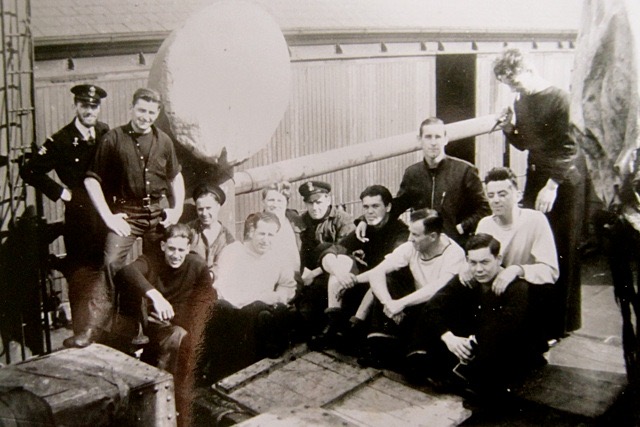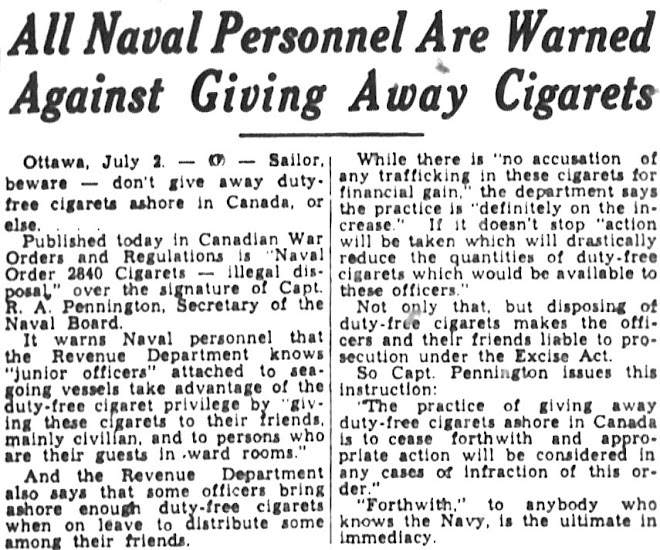Where Are the Allied Forces Destined to Invade Sicily, July 10?
News From Abroad as found in The Montreal Gazette
Armada to Sicily: Allied invasion ships set out, July 3 - 10, 1943. On
board the sloop HMS Alynbank, in convoy. © Imperial War Museum 17903
"Part of the huge Allied convoy on their way to Sicily" by Lt. E. E. Allen, RN
Introduction:
The 'Armada to Sicily', the largest in history up to that date in July, 1943, disembarked from different Allied ports at different times and took different routes to a large, secret staging area in order to not give the game away, to escape expected German resistance by way of, e.g., submarine attack, to confuse Axis leaders as to the 'when' and the 'where' the "soft under belly of Europe" was to be smashed with a sturdy, determined fist.
The 'Armada to Sicily', the largest in history up to that date in July, 1943, disembarked from different Allied ports at different times and took different routes to a large, secret staging area in order to not give the game away, to escape expected German resistance by way of, e.g., submarine attack, to confuse Axis leaders as to the 'when' and the 'where' the "soft under belly of Europe" was to be smashed with a sturdy, determined fist.
The first paragraph of the first news clipping from The Montreal Gazette below (Axis Scans Invasion Coasts) states "a big convoy battle was reported off Portugal" and that made me think of two things. First, part of the armada was made up of ships - convoys of ships - from England, if not filled with members of Montgomery's Eighth Army then at least tons of their supplies. Second, many of the Canadians in Combined Operations that I've come to know over the last ten years - and their WWII experiences via research in part (including my father, a Canadian sailor I met first in 1949... then onward) - travelled in convoys around the continent of Africa, beginning their voyages in May and/or June '43, rather than venture through the Strait of Gibraltar into the Mediterranean where serious dangers lurked in the air and under the sea.
Photographs below relate to some of the members of the RCNVR who volunteered for the British organization called Combined Operations (C. Ops.; about 1% (approx. 1,000) of those who joined the Canadian Navy joined C. Ops and became expert at handling, manning, driving various types of landing craft) and made their way to Sicily via the Cape of Good Hope and the Red Sea:
Canadians in Combined Ops aboard HMS Keren, 1943, in the 'Atlantic'
From the collection of Doug Harrison (see below)
Note the sailing date 'for Sicily', i.e., April 1943
The S. S. Silver Walnut, from the collection of Doug Harrison
Though no one has landed on the shores of Sicily yet, I include the following items from July 3 and 5 in order to provide some context related to the early days of "3 months in The Med" for Allied forces - from a Canadian newspaper's POV. Plus, I may find a particular 'star' war correspondent's stories that solve a mystery for me.
Behold, The Montreal Gazette for only 5 cents(!):
Get to the Snowdon. It's air conditioned every once in a while!
You never know if audiences will take to her
Did this happen very often?
As I mentioned in Part 1 of this (eventually lengthy) series of posts, Italy hitched its destiny to a 'ruthless war wagon', and it will soon pay. But first, Sicily (and Pantelleria) will pay.
My father wrote that when he and mates went on leave in England in the 1940s they would "paint the town brown", and I take that to mean they would drink brown ale ('paint the town red' was for wine drinkers) until it was coming out their ears. My father also mentions that he would pick up multiple cartons of cigarets (was there a cost or were they free?) before heading out the gate - or under a fence maybe (see below next article) - of the navy base or camp. Did he use them for trades, for barter? It would not surprise me.
"Len Birkenes returning on board at Irvine (Camp Auchengate, Navy)
through a makeshift gangway." From a book of Canadian Navy veterans'
stories - St. Nazaire to Singapore: Canadian Amphibious War - page 44
Most of the countries involved in WWII saw the "battle to out-produce the enemy" was of critical importance. As planes, tanks, guns, ships, etc. were destroyed, new ones were needed to replace them, and more fuel was required to power the factories. As well, more and more women were being trained to fill jobs once held by men. As WWII progressed Germany lost more and more battles on every side, including the war re production:
Rosie the Riveter is an allegorical cultural icon in the United States who
represents the women who worked in factories and shipyards during WWII,
many of whom produced munitions and war supplies. These women sometimes
took entirely new jobs replacing the male workers who joined the military.
Details in caption from Wikipedia. Photo - found at nationalww2museum
Readers can link to a short video here [01min:13sec] re bombing raid over Sicily at Palermo. Notes with the video - Various air to air shots of of Flying Fortresses heading out over Sicily. Aerial bombing shots over Marsala and Palermo. Air to air shots of a B.17 bomber with damaged tail. Various shots of the B.17 bombers after making crash landing.
In some cases German production of various types of weaponry was not an issue, but ammunition dumps were "very depleted."
An Italian mutiny leads to executions:
Canada production levels are growing. Perhaps related to weaponry,
but definitely related to the paint that protects guns from the weather.
As found in a newspaper ad, The Montreal Star, July 3, 1943.
And now on to July 5, 1943:
A Closer Look at a certain paragraph above:
About Germany, the strongest wing: There were in fact "too many Germans in the peninsula" and it is a very long peninsula.
[My father was interviewed by a reporter from The Brantford Expositor when he returned to Canada in December, 1943, after 'three months in the Mediterranean'. The reporter writes, 'LS. Harrison expects to return overseas on completion of his leave at home. He said he would not commit himself by making any prediction as to the length of the war, as the enemy was “a pretty tough customer, and will take a lot of beating.”
They sure did. Allied forces did not victoriously enter Rome until June 5, 1944, eleven months to the day after the above article was written.
More about the long learning curve as this series grows. More about the book U-Boat War can be found at WW2: Ten Poignant Stories (4) and WW2: Recommended Reading (6).
I will regularly share a few items like the one below that give a few details about WWII activity on various war fronts - world wide - because I tend to concentrate, as many readers have already discovered, on activities related to the RCNVR, particularly those sailors who volunteered for Combined Operations like my father did in late 1941.
As far as I know at this point, only 950 - 1,000 Canadians 'signed up' so to speak for that British organization on the strength of a few key details on a 'help wanted' poster a few navy boys spotted while training at HMCS Stadacona in Halifax, Nova Scotia. I.e., "dangerous duties overseas"; "small craft"; "nine days leave" thrown in. Well, who wouldn't want to see the world after getting a free pass to go home for Christmas in late 1941?
For more details about that 'help wanted' poster and how the Canadian boys embraced it, email me at gordh7700@gmail.com
What's happening out there?
Just a few details follow about how much I didn't know about my father's WWII service until well after he had passed away. These lines were inspired by the headline below, "MENACE OF U-BOAT...":
It was a very hot summer's day in Ottawa, 2012, when I entered the city via the main drag, Rideau Street, travelling from the east. (A week earlier I had been in Halifax with the goal to bury my father at sea. And I succeeded.) My motorcycle was boiling to the touch, so was I, and when I stopped at yet another red light ("I hit them all!") I flipped up my helmet's visor for some little relief, looked around for street signs to confirm I was on a good route - "I turn left in two more blocks" - in spite of nearing human spontaneous combustion levels.
Through a cloud of sweat I spotted a used book store on my right. I made a quick mental note - visit it later (because I love them). And a book title on an outdoor rack was large enough to read. Be quick, traffic's moving. U-BOAT WAR, I read. I will go back, I thought. Dad wrote about an encounter with one. And I did go back...
I did go back to the used-book store and bought the book, all 20 pounds of it. And one more. I read the second one first, it was much smaller and lighter. That being said, U-BOAT WAR was and is one of my favourite books related to WWII.
The book was later turned into a movie. Link to Das Boot
It filled me with dread and after reading the carefully compiled stats at the back of the book about 'tonnage of freight lost', 'number of ships sunk', etc., it made me say out loud, "Why would anyone want to join the Merchant Marine (MM)?" And at the time of visiting Ottawa after burying my father at sea (tossing a wooden boat filled with his ashes into the Atlantic is more like it), as per his request, I believed he had been a member of the MM. But he wasn't. He was in the RCNVR and Combined Ops.
News clippings from The Gazette continue (And no, my father wasn't in the Navy League as far as I know):
Here's a story that could also be turned into a movie! Das Plane!
Das Mayor!
Everybody loves a good comedy?
"Many planes returned with holes in the winks?" The following story could be one easily passed along to surviving family members related to (at least) one of the Canadian pilots mentioned...
What are the odds?
What are the odds of passing along the above story? Poor. I checked an online phone book re several of the above names and came up empty-handed.
An Allied invasion is in fact coming very soon:
Please click here read Research: Three Months in the Mediterranean, 1943 (1)
Unattributed Photos GH













































No comments:
Post a Comment